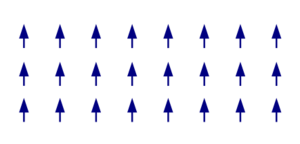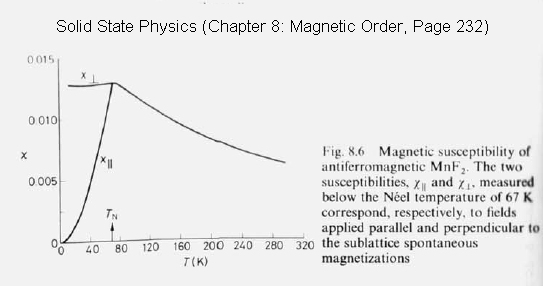Solution to Set 3
Ferromagnetism
This assignment corresponds to Section 8.3 and 8.4 in the Solid State Physics book. It deals with the topics of Magnetic Order, ferromagnetism, the Weiss molecular field.
Given Information
- Classical Ising antiferromagnet on a ”bipartite” lattice given by Hamiltonian Failed to parse (syntax error): {\displaystyle H = \frac{J}{2} \sum_{<ij>} S_i S_j -− h\sum_i S_i } ,
- Bipartite lattice: a lattice with 2 sublattices, so that each spin on sublattice A interacts only with some spin on the other sublattice B. In an antiferromagnetic state, each sublattice assumes a uniform magnetization.
- Magnetization for Lattice A:
- Magnetization for Lattice B:
- Average magnetization:
- "Staggered” magnetization: (Note: It's the difference between the two sublattices)
- for perfect ferromagnetic order
- for perfect antiferromagnetic order
Part 1
Use Weiss mean-field decoupling to replace one of the spins in the Hamiltonian by its thermal average. The Weiss field experienced by a given spin is then proportional to the sublattice magnetization on the other sublattice. Write down self-consistent equations for and , and express them through the order parameters and .
HELP!!!
Part 2
Assume that , so that , and solve the mean-field equations by expanding in . Determine the Neel (ordering) temperature, and calculate the order-parameter exponent.
The Néel Temperature
Chapter 8.4 of Solid State Physics
where
- is Néel Temperature, the onset temperature for antiferromagnetism
- is Curie constant
Part 3
Now consider a small external field , so that both order parameters can assume a nonzero value (Note: will be small). By keeping only the leading terms in and , calculate the uniform spin susceptibility , as a function of temperature. Plot as a function of temperature, and show that it has a cusp around .
Part 4
Imagine adding a ”staggered” external field , which would be positive on sublattice A, but would be negative on sublattice B. Concentrate on the system with no uniform field , and determine the behavior of the staggered susceptibility . Show that blows up at the Neel temperature.

























